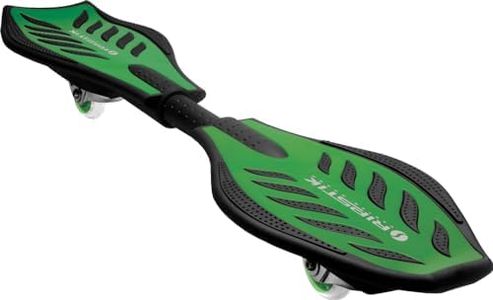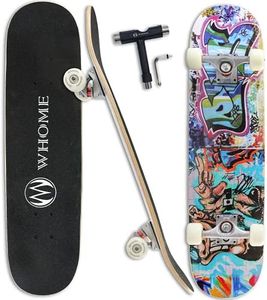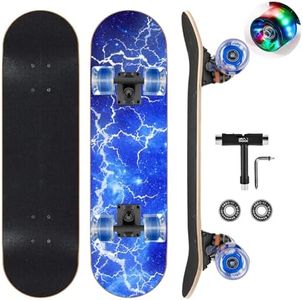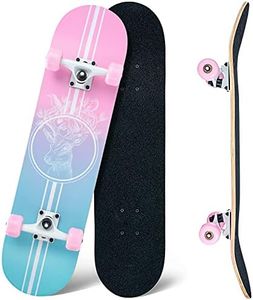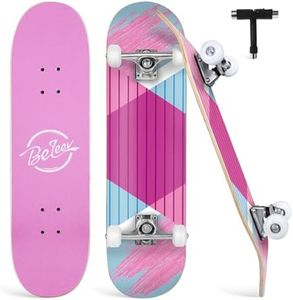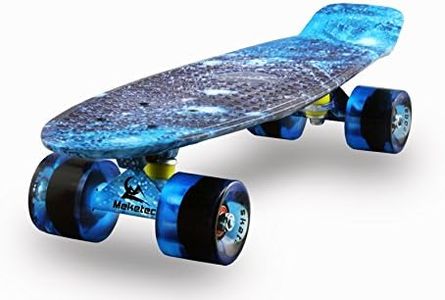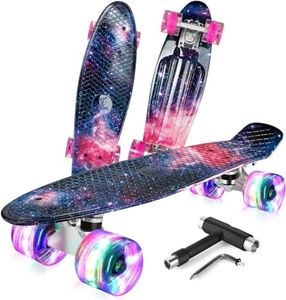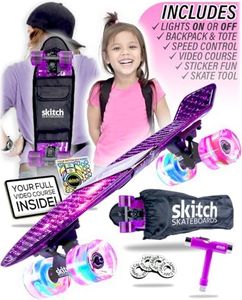We Use CookiesWe use cookies to enhance the security, performance,
functionality and for analytical and promotional activities. By continuing to browse this site you
are agreeing to our privacy policy
10 Best Skateboards For Kids
From leading brands and best sellers available on the web.Buying Guide for the Best Skateboards For Kids
Choosing the right skateboard for kids can make a big difference in how safe and enjoyable their first experiences are. At its core, a kid’s skateboard should support easy learning, comfort, and, most importantly, safety. When shopping, consider your child’s size, where they’ll ride (parks, street, or driveway), and what type of skating they want to try. Focus on boards designed for beginners and keep things simple—flashy features aren’t as important as a solid, sturdy board that fits your child’s needs.Deck SizeDeck size refers to the length and width of the skateboard’s board, which is crucial for control and comfort. For kids, a narrower and shorter deck makes it easier to maneuver, balance, and learn basic skills. Decks around 6.5-7.5 inches wide and 28-30 inches long are typically good for younger or smaller children, while slightly wider ones may be better for older or bigger kids. The right size should allow your child to stand with their feet near or just outside the bolts for good balance. Consider your child’s shoe size and height when picking to help them feel secure while riding.
Deck MaterialThe deck material affects strength and flexibility. Most skateboards use wood, commonly maple, as it’s strong yet flexible. Some may use plastic for smaller, cruiser-style boards, which are lighter but less durable for tricks. Wood is best for kids interested in skatepark or regular skateboarding, while plastic can be useful for very young beginners or those only riding smooth, flat ground. Choose sturdy materials for safety and longevity, especially if your child is likely to try out a variety of tricks.
Wheel Hardness and SizeWheels determine how smooth the ride feels and how much grip the board has. For kids, softer wheels (usually marked with a lower durometer rating like 78A-87A) absorb shocks better, making them ideal for riding on sidewalks or rough surfaces. Harder wheels (above 95A) are faster on smooth skateparks but less forgiving on cracks and bumps. In terms of size, smaller wheels (50-54mm) are easier to control and less intimidating for beginners, while larger wheels (above 54mm) go faster but require more skill. Think about where your child will ride most to decide the best combo of size and hardness.
TrucksTrucks are the T-shaped metal parts under the deck that attach the wheels and allow the board to turn. For kids, lightweight and slightly smaller trucks make it easier to control the board and help with learning to turn and balance. Trucks should generally match the deck width—too wide or too narrow can make turning harder or give less stability. Choose trucks that feel stable for your child’s weight and easy to turn when they lean.
Grip TapeGrip tape is the sandpaper-like layer on top of the deck that keeps feet from slipping. It’s essential for safety. Most beginner boards come with standard grip tape, which works well for kids. The main thing is to ensure it's firmly attached and covers the deck so your child can ride confidently. You don’t need fancy designs—solid, reliable grip is most important for young riders.
Board WeightLighter boards are easier for kids to carry, control, and practice basic moves with. However, boards shouldn’t be so light that they feel flimsy. Most beginner boards for kids strike a good balance between sturdiness and low weight. If your child is very small, prioritize a board that they can easily carry by themselves.
